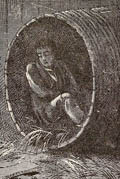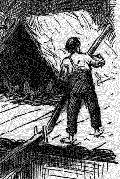|
Hannibal, Missouri, a bustling, wide-awake
American city of over twenty thousand, would never be
recognized to-day as "the poor little shabby village of St.
Petersburg" of Tom Sawyer's day. Indeed, in later years
when Mark Twain visited the town of his boyhood he
expressed surprise and admiration for its improved
appearance and progressiveness.
The mile-wide Mississippi is magnificent
there, with "Pirate's Island" just across from the railroad
yards, and Lovers' Leap, and Holliday's Hill to the north,
blocking the further progress of Main Street, for Hannibal
was a "Main Street town in the reign of Tom" and "Huck" and
"Injun Joe."
Nature made Hannibal a playground for
youth at the cost of not one cent to the municipality. The
hand of man could not improve upon it.
It provided a towering hill down which
great boulders could be started, to land on the street far
below with a delicious crash. It created bays and islands,
fishing holes and swimming pools, far-reaching stretches of
gloomy woodland, crevices and hollows, and capped it all
with a mysterious cave that had no end! "It was said that
one might wander days and nights through its intricate
tangle of rifts and chasms, and never find an end of the
cave." . . .
Some years before the death of Mark Twain,
Mr. and Mrs. George A. Mahan of Hannibal purchased the
Clemens house, and presented it to the city as a permanent
memorial. It is kept in as near as possible the same shape
as when the family occupied it. The little back yard is
there, almost exactly as when Jim Wolf, the printer boy,
undertaking to shoo away the cats, fell through the grape
trellis and landed on the hot candy Parmela and her girl
friends put out there to cool. Mrs. Mary Wirtz, the matron,
is asked to often by tourists about the "cats" that she has
one as a regular attaché of the house to satisfy
their curiosity. . . .
Perhaps the most relentless character ever
created by Mark Twain was "Injun Joe," the savage
half-breed of Hannibal. Readers of Tom Sawyer will remember
him well.
But Doc Brown . . . declared he knew
"Injun Joe" well, and that he was not a bad man at all. He
said he ran with the boys and helped them in hunting
rabbits and 'possums, and showing them good places to fish.
"Injun Joe" finally became a deck hand on the ferryboat, he
said, and died of pneumonia.
When the Mark Twain statue was erected in
the River View Park at Hannibal, a question arose about the
word "humorist" in the inscription. The monument committee
favored it, but Mr. Albert Bigelow Paine opposed it on the
ground that Mark Twain's career was far greater than that
of a "humorist."
While the matter was being discussed, the
writer asked Mr. Mahan how he would classify Missouri's
noted son.
"A citizen of the world," replied Mr.
Mahan. "That is big enough to cover the matter, for all the
world loved Mark Twain." Then he added:
"Take him as a whole, I would say Mark
Twain was a man who invested lavishly in humanity's stock,
and made the dividends payable to the world."
MARK TWAIN MEMORIAL PARK
During the year 1923 a Mark Twain Memorial
Park was created, consisting of one hundred and six acres
of land adjoining the village of Florida, Missouri, where
Mark Twain was born and where he played and hunted when a
boy. An organization has the matter in charge, and the
schools, newspapers, and Mark Twain societies in all the
towns of the state are raising the fund required to
establish the park and maintain it in a style worthy of the
man whose memory will keep it green.
A twelve-year-old camp-fire girl, Ruth
Lamson of Moberly, suggested the idea of a park. Ruth and
her comrades had enjoyed their vacation amidst the
fascinating scenery along the little river for several
years, the guests of M. A. Violette, owner of the Mark
Twain birthplace at Florida. Mr. Violette had put up
several rustic camping houses for the girls, and of course
they called him "Dad," which he accepts as a mark of
affection--as it is.
"Dad" Violette's camp-fire girls were not
the pioneers, however, in the discovery that the Salt River
country was the prettiest and most rugged in northern
Missouri. Sam Clemens made it the playground of his youth,
when he would spend his summers at Florida as the
well-loved guest of his remarkable uncle Judge John A.
Quarles. The Clemens family lived in Hannibal then.
Judge Quarles ran a store at Florida, and
owned a farm near the place. In his autobiography Mark
Twain gave a pretty fair inventory of that store from
memory, and the prices at which articles were sold. He
recalled that, "if a boy bought five or ten cents' worth of
anything, he was entitled to half a handful of sugar from
the barrel." If the customer were a woman, she was entitled
to a spool of thread with her purchase. If a man bought
some goods--no matter how trivial--his "prize" was a drink
of whisky. Whisky sold then (from 1830 to 1840) at ten
cents a gallon!
The author of "Innocents Abroad" returned
in his last years to the old Missouri playground, the
woodlands they are going to transform into a beautiful park
in his honor. In one of his most famous addresses--on the
celebration of his attaining three-score years and ten--he
voiced his vision of the old playground.
"I can see the woods in their autumn
dress, the oaks' purple, the hickories washed with gold,
the maples and the sumacs luminous with crimson fires, and
I can hear the rustle of the fallen leaves as we plowed
through them. I can see the blue clusters of wild grapes
hanging amongst the foliage of the saplings, and I remember
the taste of them and the smell. I know how the wild
blackberries looked, and how they tasted; and the papaws,
the hazelnuts, and the persimmons; and I can feel the
thumping rain of hickory nuts and of walnuts upon my head
when we were out in the frosty dawn to scramble for them
when the gusts of wind loosened and sent them down."
"Dad" Violette saved the Clemens home some
ten years ago when the owner was about to wreck it for
firewood. He bought and repaired it, all but a lean-to,
which had rotted too badly to restore. When Mark Twain saw
the house on one of his later visits to Florida he
commented upon the absence of the lean-to. He remarked that
the little house was in better shape than when he saw it
after he moved to Hannibal.
Miss Ruth Lamson spoke of the park idea to
"Dad" Violette, who immediately became interested. The
girl's father, Frank B. Lamson, is secretary of the Moberly
Chamber of Commerce. Mr. Lamson decided that as Mark Twain
had been a printer, and newspaper man, the men of those
crafts should take hold of the matter. The result was the
organization of the Mark Twain Memorial Association.
Mr. Violette has agreed to give the Mark
Twain home for the park, together with its valuable
contents of pioneer relics. There are two Seth Thomas
clocks, one said to be one hundred and thirty-five years
old and the other one hundred years. There is an old
spinning wheel, also Indian axes, arrow heads, ancient guns
and swords, and so on.
In a prominent place in the park it is
proposed to erect a statue to represent "Tom Sawyer" and
"Huck Finn." The entrance by way of Florida will be through
an imposing gateway, the arch overhead bearing the
inscription "Mark Twain Memorial Park."
The Mark Twain Park Association was
granted a decree of incorporation in February. The
development scheme, as worked out by Horace Major, the
University of Missouri landscape artist, includes roads,
buildings, landscaping, electric lights, waterworks, and
other interesting features.
Newspapers, schools, and interested
individuals in Missouri are working enthusiastically over
this beautiful memorial to the man who laughed through
life, and who made so many millions of his fellow men
laugh--and think.
|


